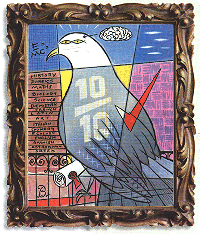Bird's-eye view of art
|
Meet the pigeon who knows a thing or two about Picasso
GARETH HUW DAVIES
Are pigeons smarter than art students? In tests a pigeon was
able to spot subtle differences between abstract designs that university
students did not notice. It could even tell a Picasso from a Monet, though,
in this case, the students' blushes were spared as they showed that they,
too, could distinguish between the two artists.
The pigeon, not previously thought of as terribly bright, is
one of the new bird (and other) brains featured in BBC2's Animal Minds. The
three-part series reveals new insights into the way animals think, solve
problems, grasp concepts, talk and learn.
Some show quite astonishing mental abilities. The nutcracker,
a type of crow, may have the animal world's ultimate memory. It collects
and stores 30,000 pine seeds during the autumn and, over the next eight months,
manages to retrieve more than 90 per cent of them.
One of the smartest creatures of all, the dolphin, can interpret
sentences, according to their construction. Dolphins correctly followed these
instructions: "Take the right basket to the left water" and "Take the left
basket to the right water."
The series shows that
animal "intelligence"
maybe wider than we thought. But though creatures may outperform us on
some tests, they can still fail - as the "star" pigeon did - apparently simple
tasks. It concludes that social needs drive creatures to become smarter.
A complex social world requires a higher level of intelligence;
dolphins and chimps,
humans and
parrots are
all highly social - and smart animals.
 |
According to researchers in Germany, bees can
count... In an experiment, honey bees were trained to fly from their hive to a sugar feeder four landmarks were then placed along their line of flight with the sugar feeder between the third and fourth.
The position of the original sugar feeder was then changed and
the number and position of the landmarks altered radically: a new feeder
containing no sugar was placed between the third and fourth landmark.
On the subject of clever flying things,
Tomorrow's World this week hears witness
to the incredible way that moths manage to stay in the air. An enormous motorised
hawkmoth manages to prove yet again just how brilliant nature is. |
| The amazing beating action of the wings causes
a vortex, a small tornado, to roll along the front of each wing. This speeds
the flow of air over the top and gives the hawkmoth the lift it needs to
fly. Who knows, aircraft manufacturers may yet try to replicate it - stranger
things have happened. Fasten your seatbelts... we're heading for a honeycomb.
Radio Times |
|
 |
This little piggy went to MENSA
Brainy Babe may be just the beginning: now scientists believe that pigs are so clever they could one day talk to us.
Pigs are cleverer than you think. No, no, much cleverer.
According to research carried out in America by Professor Stanley Curtis
- focus of this week's QED Move Over Babe! pigs can play computer
games, respond to verbal commands and, one day soon, they'll be talking to
us. "What QED will show," says Curtis, "is that pigs are able to do many
quite artificial things that have surprised people who specialise in animal
intelligence. We are at the beginning of our work, but already have results
that some people will find fantastic."
Curtis's pigs use their snouts to move joysticks, to hit targets
on a computer screen with a cursor. "They have a hit rate of well over 80
per cent," he says. "With primates, a typical contingency is 70 per cent."
So pigs might be able to play computer ping-pong? "Yes, they could."
Away from the computer, pigs can fetch
 objects on request. QED even carries out an experiment to see
if a pig could herd sheep, as the one in the movie Babe does.
objects on request. QED even carries out an experiment to see
if a pig could herd sheep, as the one in the movie Babe does.
But the motivation behind Curtis's experiments has always been
the animals' welfare. In five to ten years' time, he suggests, we may be
communicating with pigs, once we understand their squeals and grunts and
can use them to form a rudimentary language. "Previously, we have had to
judge from pigs' overt behaviour how they feel," says Curtis "It would be
so much more precise for the animal to tell us itself .
NICK GRIFFITH RT 31 May - 6 June 1997
